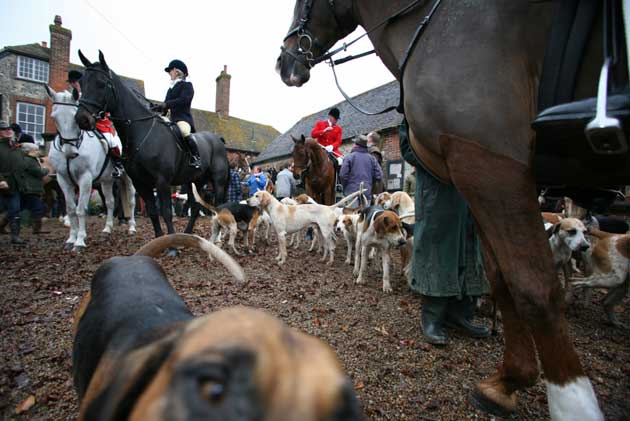Non-hunting season opens with a nudge and wink
They don't kill foxes any more, do they? Well, not while anyone's looking, anyway. It's just a good healthy ride in the country. Tally ho!

Your support helps us to tell the story
From reproductive rights to climate change to Big Tech, The Independent is on the ground when the story is developing. Whether it's investigating the financials of Elon Musk's pro-Trump PAC or producing our latest documentary, 'The A Word', which shines a light on the American women fighting for reproductive rights, we know how important it is to parse out the facts from the messaging.
At such a critical moment in US history, we need reporters on the ground. Your donation allows us to keep sending journalists to speak to both sides of the story.
The Independent is trusted by Americans across the entire political spectrum. And unlike many other quality news outlets, we choose not to lock Americans out of our reporting and analysis with paywalls. We believe quality journalism should be available to everyone, paid for by those who can afford it.
Your support makes all the difference.Horses crowded the car park of the village pub, hounds dodging round their hooves. Riders drank whisky mac in the saddle while anti-hunt campaigners watched from the edge of the crowd. So far, so traditional. But as the Southdown and Eridge Hunt held its first meeting of the year yesterday, along with more than 300 others across the country, nothing was really as it seemed.
The fox-hunting season had started, but nobody would admit to hunting foxes. Not on the record, anyway. The antis were claiming it was all going to be done in secret, as before, but at the start of the third season since it was banned by law they still had not come up with compelling evidence.
The police were supposed to be enforcing the Hunting Act 2005, but there was no sign of them in the drizzle and gloom of Firle, a village on the South Downs in East Sussex. Meanwhile both sides – for and against – were saying their people had turned out in record numbers.
"The whole thing is a farce," said Julia Caffyn, one of three masters of the Southdown and Eridge. The redoubtable 67-year-old was aboard a thoroughbred mare of equal vintage in equine terms, called Priscilla, outside the Ram Inn.
She didn't mean hunting, of course. That was apparently flourishing despite the ban – and despite the predictions of the Countryside Alliance – with three new hunts since 2005 and an estimated 50,000 participants yesterday. No, Mrs Caffyn meant the law. "We ride according to the letter of the law, laying down a trail with a fox brush dipped in urine, but the law is unenforceable anyway."
Other hunters contacted by the IoS agreed, insisting that they all did as they were told and called off the hounds if a real fox wandered across the trail, but admitting "sometimes accidents happen". One hunt regular further north in England said: "If we go into the woods on a wet Wednesday afternoon there is never anyone around to see what happens and yes, foxes do get killed in the old way."
Was that true of the Southdown? "I won't say it's never happened," said Mrs Caffyn, "but you try to stick to what you should be doing at all times." No written records were kept and the police were rarely seen – but the full-time professional huntsman knew every aspect of the law, she insisted, and the last thing the Southdown needed was the expense and trouble of a long legal battle.
Not that there have been many. Fewer than 30 cases, and the Countryside Alliance claims only three of those convicted have been members of traditional hunts.
Anti-hunt campaigners believe rural police officers are "a bit unclear and need clarification on the law", according to Barry Hugill of the League Against Cruel Sports. It is working with the RSPCA and the International Fund for Animal Welfare to set up a new website later this month, aimed at helping the police understand the issues more clearly.
The league has recruited a record number of monitors this season, including professionals, he said. "Our teams will be equipped with hi-tech surveillance equipment. Their major function is to let hunts know they are being watched." But despite watching for two seasons, they have yet to publish evidence of widespread flouting of the ban.
Yesterday afternoon a lone dog came bounding out of the mist and murk of fields north of Firle, following the scent. Behind was the pack, then the hunt professionals in scarlet coats, the regulars in navy and at the back of the field, still riding hard, red-faced children in tweed. One was crying with the cold. And all in vain: no fox was spotted yesterday.
But if it was all just a jolly ride in the country – albeit a tough, mud-spattered one – why were antis not welcome to look? "They are such a pest, shouting abuse," Mrs Caffyn had said before the off, and, remembering their balaclavas, "apart from anything else they look so awful".
So off we go, tally ho! The season has started: the antis are chasing the hunters, the hunters videoing the antis in return, the police trying not to think about all those burglars getting away. The only creature not in the hunt these days – officially, but accidents do happen, officer – is the fox.
To have your say on this or any other issue visit www.independent.co.uk/IoSblogs
Join our commenting forum
Join thought-provoking conversations, follow other Independent readers and see their replies
Comments